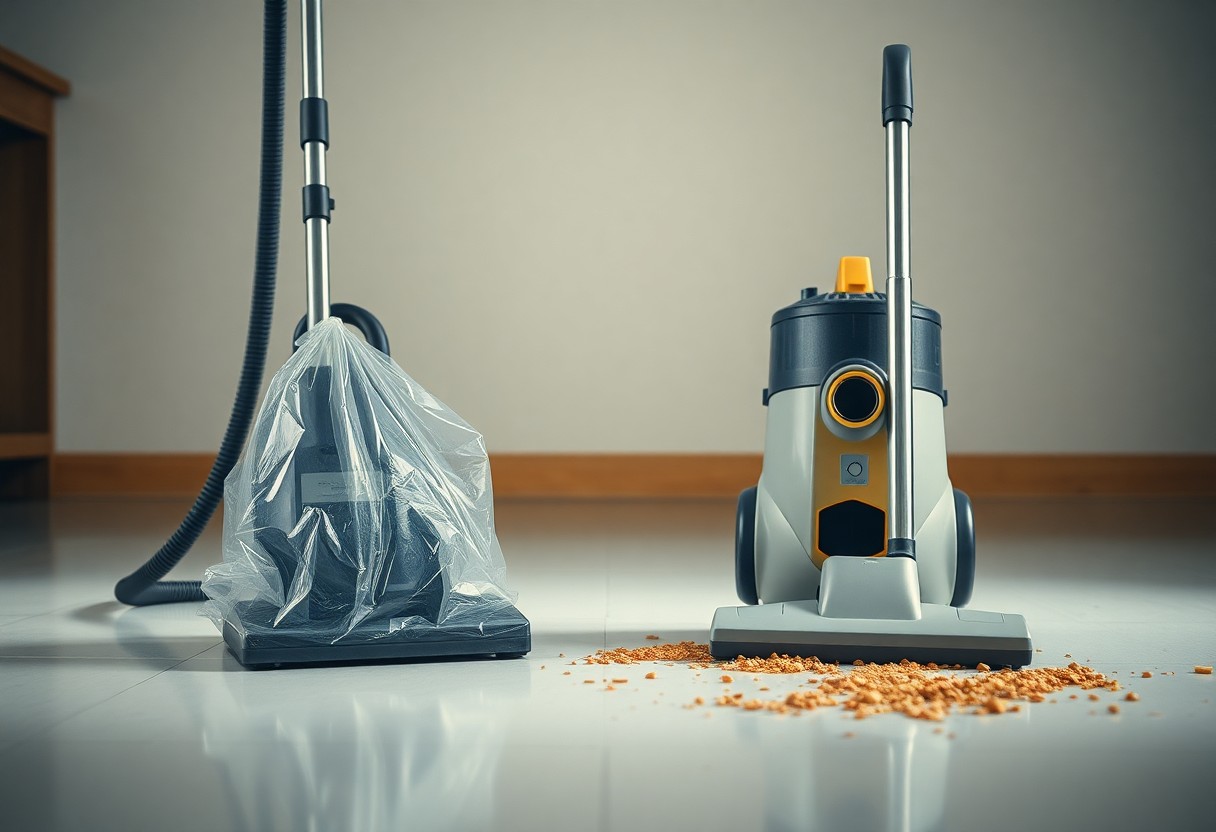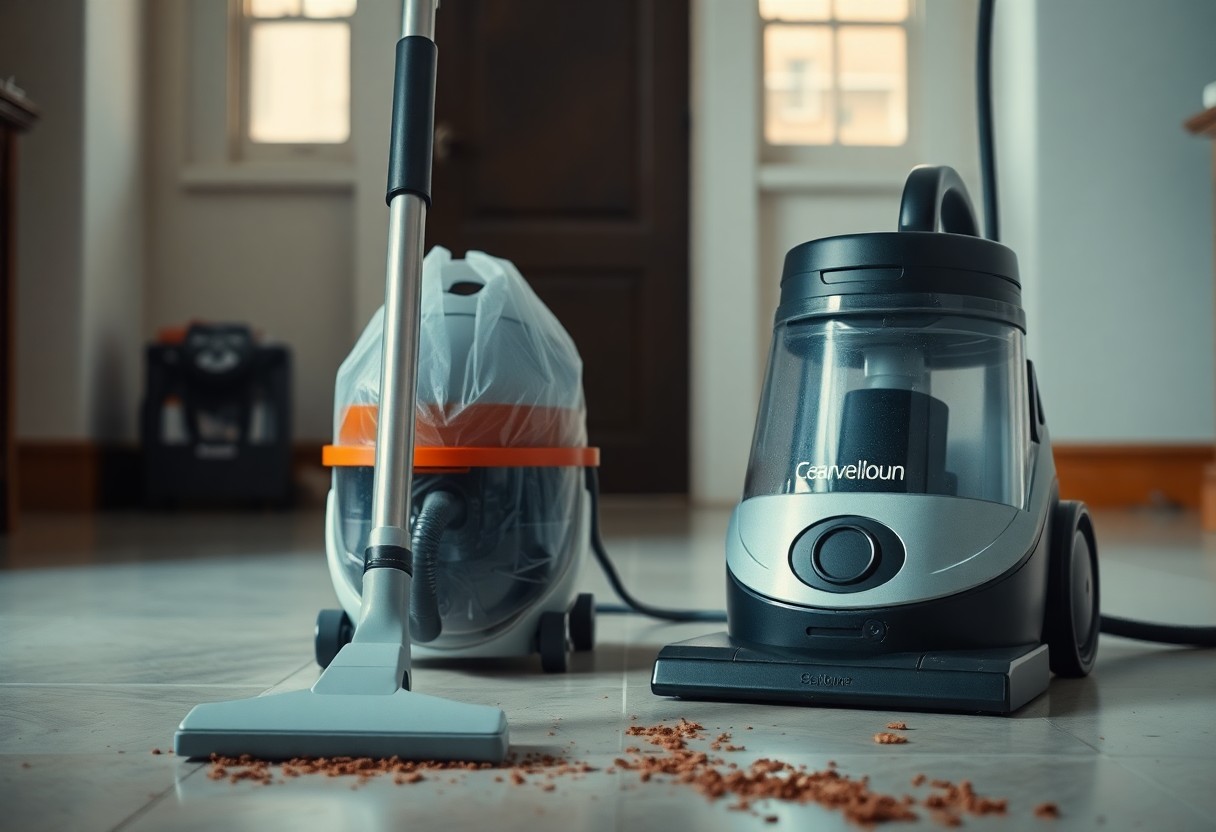Pros and cons abound when choosing between bagged and bagless vacuums, making it vital for you to understand the differences to select the best option for your cleaning needs. Each design comes with its own set of advantages and disadvantages that can impact your cleaning efficiency, maintenance efforts, and overall satisfaction. By delving into this comprehensive comparison, you’ll gain valuable insights into the function, upkeep, and performance of both types, empowering you to make an informed decision that aligns with your lifestyle and preferences.
Contents
Understanding Bagged Vacuums
To understand bagged vacuums, it’s important to know that these appliances use disposable bags to collect dirt and debris. As you vacuum, dust and particles are sucked in and trapped within the bag, which helps to maintain cleaner air quality in your home. Bagged vacuums are often favored for their efficiency and convenience in removing allergens from your living space.
How They Work
Beside using a filtration system, bagged vacuums function by drawing in air through a motor that creates suction. As the air moves into the vacuum, it passes through the bag, which captures dirt while allowing cleaner air to exit, contributing to better indoor air quality and reducing allergens.
Advantages of Bagged Vacuums
Bagged vacuums offer several benefits that enhance your cleaning experience. They are typically more hygienic, as the bags contain dust and allergens securely, reducing exposure when changing bags. Additionally, they often require less frequent maintenance and cleaning since the bags can hold more debris without clogging.
Advantages of bagged vacuums include their ability to effectively trap dust particles and allergens, making them a great choice for allergy sufferers. The sealed bags prevent dirt from escaping back into the air, resulting in cleaner indoor air. You’ll appreciate that most models have a larger capacity compared to their bagless counterparts, so you can vacuum more before needing to replace the bag. Plus, the process of emptying and changing bags is mess-free, minimizing your contact with collected dust and debris.
Disadvantages of Bagged Vacuums
Above all the advantages, bagged vacuums come with a few drawbacks. For instance, the need for purchasing replacement bags can add to your long-term costs, and the process of changing bags can be inconvenient for some users. Additionally, the performance of your vacuum depends on the quality of the bags used.
Further exploration into the disadvantages reveals that reliance on disposable bags can be less environmentally friendly compared to bagless options. You might also find that certain models can lose suction as the bag fills up, necessitating more frequent changes than you might prefer. Overall, while bagged vacuums have many benefits, these disadvantages should be carefully considered to determine if they align with your cleaning needs and lifestyle.

Understanding Bagless Vacuums
Assuming you are considering a vacuum cleaner, bagless vacuums are designed to collect dirt and debris in a transparent canister instead of a disposable bag. These models often utilize advanced filtration systems and cyclonic technology, allowing you to easily see when the canister is full and ready for emptying. This design aims to enhance convenience and reduce the ongoing costs associated with purchasing replacement bags.
How They Work
By utilizing powerful suction and airflow, bagless vacuums draw debris into the canister. As dirt enters, centrifugal force helps separate larger particles from the air, which then flows through a series of filters. Once the canister is full, you simply detach it for easy disposal and cleaning, eliminating the need for bag replacements.
Advantages of Bagless Vacuums
Behind the appeal of bagless vacuums lies their convenience and cost-effectiveness. You avoid the recurring expense and hassle of buying replacement bags. Additionally, many bagless models boast optimized filtration systems that can capture more dust and allergens, which is especially beneficial for allergy sufferers. Their transparent canisters also allow you to monitor fill levels, ensuring you don’t lose suction performance.
Understanding the advantages of bagless vacuums helps you appreciate their modern design. You can easily identify when to empty the canister, leading to less downtime during cleaning sessions. Many bagless options also feature advanced filtration systems designed to trap small particles, which can improve air quality in your home. Overall, bagless vacuums can offer a more user-friendly and cost-effective cleaning solution compared to their bagged counterparts.
Disadvantages of Bagless Vacuums
By considering the disadvantages, you should be aware that bagless vacuums may require more frequent maintenance. The canisters need to be emptied and cleaned regularly to maintain optimal performance. Some users also find the exposure to dust during emptying to be a downside, especially if not done carefully. Additionally, depending on the model, the suction power may diminish as the canister fills up.
To help you make an informed choice, it is important to acknowledge the downsides of bagless vacuums. You may experience a dust cloud when emptying the canister, which can be an issue for allergy sufferers. Moreover, if the filters are not regularly cleaned or replaced, they can become clogged, negatively impacting suction power and performance. Overall, if you’re willing to invest in regular maintenance, a bagless vacuum can still be a practical solution for your cleaning needs.
Performance Comparison
Once again, it’s necessary to evaluate how bagged and bagless vacuums perform during cleaning tasks. Below is a concise comparison of their performance metrics:
| Metric | Bagged Vacuums | Bagless Vacuums |
|---|---|---|
| Suction Power | Consistently strong and reliable | May decrease as the dirt bin fills |
| Filtration Efficiency | High, often includes HEPA filters | Varies; some lack efficient filtration |
| Maintenance and Convenience | Easy to replace bags, less mess | Requires frequent emptying and cleaning |
Suction Power
The suction power of bagged vacuums is generally more consistent since the sealed bag prevents airflow restrictions, allowing them to maintain strong suction throughout their use. In contrast, bagless vacuums may experience diminished suction as the dust bin fills, potentially affecting cleaning effectiveness.
Filtration Efficiency
Against common belief, the filtration efficiency of vacuums can vary significantly between bagged and bagless models. Bagged options often feature high-quality filters that trap allergens and fine particles, which is particularly beneficial for allergy sufferers.
Power and quality of filtration in bagged vacuums provide a cleaner exhaust and a healthier home environment. This advantage makes them especially suitable for individuals with sensitivities, ensuring that dust and allergens remain contained within the bag, unlike some bagless models that can release particles back into your home.
Maintenance and Convenience
Around the maintenance aspect, bagged vacuums are often more convenient as you simply need to replace the bag when it’s full, resulting in less mess. Bagless models, on the other hand, require you to frequently empty the dirt bin, which can be less hygienic and time-consuming.
This regular emptying can sometimes be a hassle, especially if you tackle large cleaning jobs. Additionally, without regular cleaning of the dirt container and filters, a bagless vacuum can diminish in performance over time, making maintenance an important factor to consider in your decision.

Cost Analysis
Unlike bagged vacuums that incur ongoing costs for purchasing replacement bags, bagless vacuums provide a one-time purchase solution. However, both types carry different financial implications that you should consider when weighing your options.
Initial Purchase Price
Analysis of the initial purchase price reveals that bagged vacuums often range from budget-friendly models to high-end options, generally starting at a lower price point. In contrast, bagless vacuums can also vary widely in price, but many advanced models tend to be more expensive. Therefore, your choice may depend on your budget and specific requirements.
Long-Term Costs
Alongside the initial investment, it’s important to evaluate long-term costs associated with both vacuum types. Bagged vacuums typically require purchasing new bags regularly, which can add up over time. Bagless models, while saving you on bag expenses, may incur costs related to filter replacements or specialized maintenance, depending on the model you choose.
The ongoing expenses for bagged vacuums can quickly escalate, especially if you have a larger home or frequent cleaning needs that demand higher bag usage. On the other hand, although bagless vacuums eliminate the need for bags, you will have to factor in the cost of replacing filters and maintaining the vacuum, which can also contribute to your overall expenses. Weigh your cleaning habits and frequency against these factors to determine which option best suits your financial situation in the long run.
Environmental Impact
Keep in mind that the environmental impact of vacuums can vary significantly between bagged and bagless models. While bagless vacuums may seem like a more eco-friendly choice due to reduced waste from vacuum bags, they can create other issues, such as the efficiency of various filters and dust disposal methods. In contrast, bagged vacuums often end up in landfills, but they contain dust and allergens more effectively, which can be important for improving indoor air quality.
Waste Generation
Between bagged and bagless vacuum cleaners, bagged models typically produce more waste due to the disposal of bags. Each time you replace a bag, you contribute to landfill waste, impacting the environment over time. Conversely, bagless vacuums generate less packaging waste, but they still require regular filter replacements, which can also add to environmental concerns.
Recycling Options
Environmental awareness has led to more recycling options for both types of vacuum cleaners. Bagged vacuums with paper bags can sometimes be composted, while some bag manufacturers offer recycling programs. Bagless vacuums typically have reusable parts, and their plastic components may be recyclable, depending on local facilities.
Generation of recyclable materials in your vacuuming routine can make a significant difference in reducing your environmental footprint. You can explore local recycling options for used vacuum bags and other components. Many manufacturers provide take-back programs, which allow you to send in old bags or non-functioning parts for recycling. Supporting such initiatives will help in minimizing waste while promoting a more sustainable approach to cleaning your home.
User Preferences and Considerations
Now that you understand the fundamentals of bagged and bagless vacuums, your preferences and considerations come into play. Each type has its unique benefits that cater to different needs. To help in your decision-making process, check out Bagless vs. bagged vacuum cleaners: Here’s how to ….
Lifestyle Factors
For many people, lifestyle factors heavily influence their vacuum choice. Your daily routine, cleaning frequency, and potential allergies are all important aspects to consider:
- Do you have pets that shed?
- Are you prone to allergies?
- How often do you clean your home?
Knowing these factors will help you choose a vacuum that aligns with your lifestyle.
Home Environment
Behind your home environment, the type of surfaces you maintain plays an important role in your vacuum selection. The layout and flooring of your space can significantly impact the effectiveness of either bagged or bagless vacuum models.
To optimize your cleaning routine, consider whether you primarily have carpets, hard floors, or a mix of both. Bagged vacuums often excel on carpets due to better filtration and suction power, while bagless vacuums can be more efficient for quick clean-ups on hard surfaces. Your specific environment can ultimately dictate which vacuum best fits your needs.
Summing up
Taking this into account, the choice between bagged and bagless vacuums hinges on your personal preferences and needs. Bagged vacuums typically offer better filtration and less mess, while bagless models provide the convenience of not needing to buy bags. Consider your cleaning habits, allergy concerns, and maintenance willingness to find the vacuum that best suits your lifestyle. Ultimately, understanding the pros and cons of each type will empower you to make an informed decision that enhances your cleaning efficiency and comfort.

Leave a Reply